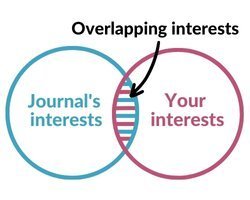Reading time: About 3 minutes
If you’re an academic seeking publication in a peer-reviewed journal, here’s a trick that will dramatically increase your odds of success….
I seldom write posts aimed at only one segment of my audience, but today’s column is intended for academics and grad students. If you don’t fall into that category, I’ll be back next week.
Are you an academic writer who is struggling to have a paper placed in a peer-reviewed journal? If so, I’m guessing you probably wrote your paper first, and then combed through the literature trying to find a home for it. And you probably received more than one rejection.
If this is your situation, please consider following some advice that may strike you as counter-intuitive or even crazy.
Don’t begin by deciding what you want to write.
Instead, begin by figuring out what your target publication is looking for and then writing to meet their needs.
You’ll have far faster success if you approach your work in this fashion. (It’s the academic version of catching more flies with honey than with vinegar.)
“But how do I figure that out?” I can hear you asking. Or, maybe you’re saying, “I’m a scientist who’s an expert in ____ . I can’t write about anything else. Shouldn’t it be obvious that my topic has to take precedence?”
Actually, no. Your job is different from the job facing publications. They have their own mandate and mission statement and their own entirely different objectives. Also consider that in some ways they will be doing you a favour by publishing your work and you need to return the favour by not wasting their time.
Here’s how I suggest you proceed: Think of your job (writing about subject X) and their job (publishing articles about subject X) as a Venn Diagram. And you need to address the sweet spot in the middle:
But if your Venn Diagram looks like this…
…there’s no point in trying to write for that particular publication – you’ll only be wasting your time.
If you’re an academic with some experience, you probably already know the names of the publications in which you’d like to appear. And you may even have them ranked as tier 1, 2 and 3. But consider how much more successful you could be if you honed your approach first, tying one paper to one publication.
But if you’re new to the business, you may not know where to begin. So, here’s what I suggest:
Start by looking at your own citations. If you’re regularly citing a particular pub, it’s likely of interest to your field and may be a good candidate for your own work.
But don’t settle for the name of just one publication. Generate a list that’s at least six to 12 names long.
And if you’re unable to do that based on the citations that appear in your own writing, speak with colleagues and supervisors. What pubs do they suggest you aim at? What do they think would be a good fit for you and your area of study and your style?
Once you have your list, start doing some research. Go to the website for the publication. Check out their mission statement, usually called a scope statement, and read a half dozen back issues. Make notes for yourself and enter them into a spreadsheet.
Then tailor your approach of your next article to the needs of one of these pubs. I’m going to assume that the subject requirements are obvious. You wouldn’t try to place a piece about engineering in the Psychology of Popular Media journal. But there are other issues that are just as important.
If the publication runs articles that are only case studies, then you need a case study to succeed with it. If the publication expects quantitative research, then that’s what you need to provide. Or, if it wants qualitative research, then do that.
Of course, many journals will run more than one type of article — often a combination of the three types I’ve described above. But if they don’t, you shouldn’t expect to be the exception. Give them only what they want.
And nowhere is the concept of giving them what they want more important than with philosophy and length. If the journal focuses on broad issues, give them only broad issues. If they focus on specifics, give them only specifics. And if they say their maximum length is 8,000 words, you must not give them one more word than that. It’s disrespectful and you are bound to fail.
Next, be sure to consider what articles they have run in the last year. As tremendous as your paper on “the economics of TikTok for 12-year-olds” might be, if the journal has recently published something on a similar topic, they’re unlikely to be interested.
Finally, be sure to meet all their technical expectations: Give them the citations in the format they require, make margins the right width, use the specified font size etc. etc. These demands may be tiresome to you but for any publication dealing with hundreds, perhaps thousands of submissions every year, having these demands is the only way they can maintain their publication schedule — and their sanity.
Starting your research and writing with the end in mind — the name of the journal in which you wish to be published — is of course no guarantee of publication. But it increases your odds dramatically.
Writing first and looking for a home for your paper is a high-risk enterprise, and is far more likely to end in disappointment.
If you read a journal and think, “that’s the kind of paper I’d like to write,” or, even better, “that’s the kind of paper I’ve written in the past,” then you are far more likely to succeed in being published by them.
Thanks to George Stroubakis for reading and commenting on an early version of this post.
*
My video podcast last week provided tips for freelance writers. Go here to see the video or read the transcript, and you can also subscribe to my YouTube channel.
*
Need some help developing a better writing routine? Learn more about my Get It Done program. There is turn-over each month, and priority will go to those who have applied first. You can go directly to the application form and you’ll hear back from me within 24 hours.
*
How do you succeed at getting your work published in peer-reviewed journals? We can all learn from each other so, please, share your thoughts with my readers and me in the “comments” section below. Anyone who comments on today’s post (or any others) by April 30/23 will be put in a draw for a digital copy of my first book, 8 1/2 Steps to Writing Faster, Better. To enter, please scroll down to the comments, directly underneath the “related posts” links, below. Note that you don’t have to join Disqus to post. See here to learn how to post as a guest. It’s easy!




